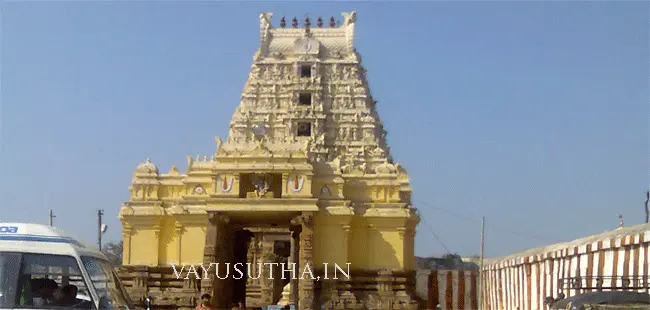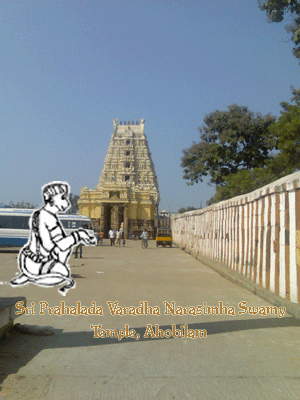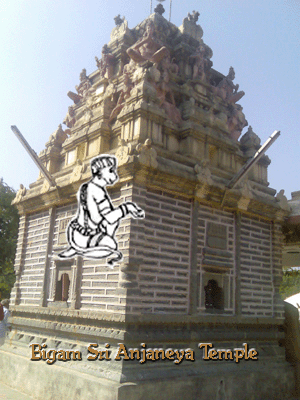
Ahobilam
Ahobilam is located in the Kurnool district of Andhra Pradesh in the hills known as Garudadri of the Eastern Ghats and is about 400 KM northwest of Chennai.
The place is famous for the nine shrines for Lord Narasimha located within a radius of five kilometers. Ahobilam is known in two parts. The lower plain of the hill is known as Diguvu Ahobilam i.e. Lower Ahobilam where the temple of Sri Prahalada Varadhan [another name for Lord Narasimha] is located. The second part is known as Eguvu Ahobilam or Upper Ahobilam where the nine shrines of Lord Narasimha are located. While it may be easy to reach the lower Ahobilam by road, the upper Ahobilam is in the Garudadri mountain range and the difficult terrain is to be covered only by trekking.
Significance of Ahobilam
Ahobilam is a part of the Eastern Ghats. It is believed that the Eastern Ghats form a picturesque divinity of the great serpent Sri Adisesha with its hood at Tirumala, its middle at Ahobilam, and its tail-end portion at Srisailam. Therefore all these three places are considered the most sacred and in Tirumala we have the abode of Sri Venkateswara, at Ahobilam that of Lord Nava Narasimha, and at Srisailam Lord Maligarjuna.
Ahobilam: The name
Devas after the darshan of Lord Vishnu in the fierce form of Lord Narasimha when slaying the demon king Hiranyakasipu were wonder-struck and exclaimed “Ho! What strength” – Ahobalam in Sanskrit [Aho is an exclamation Balam means strength]. Later it became Ahobilam. A variant to this is that Sri Garuda undertook the penance to see Lord Vishnu as Lord Narasimha in a cave and had darshan of the Lord; hence the entire place came to be known as Ahobilam. Aho is an exclamation word. Bhilam (bhilam means cave). It is equivalent to 'oh the mighty cave' and thus aho-bhilam of lord Narasimha Swamy.
Sri Anjaneya, the absolute devotee of the Lord, has been chosen to guard the main temple and has not only a complete view of the temple but also an uninterrupted darshan of the Lord. after the closing of the sannidhi for the day it was the practice of the temple priest to hand over the keys of the main temple to Sri Anjaneya here [though symbolically].
Sri Prahalada Varadha Narasimha Swamy
A huge temple for Lord Sri Prahalada Varadha Narasimha [Sri Narasimha who bestowed boons to Prahalada] with three prakarams is the main temple in Lower Ahobilam. Since the Lord had bestowed His grace on Bhakta Prahalada the Lord of this kshetra is called Sri Prahalada Varadhan. [For details about Bhakta Prahalada/ Narasimha Sri Yoga Narasimha] Sri Vishnu’s consort Sri Mahalakshmi took birth as a human in a tribe, named Chenchus and married Lord Narasimha hence she is named Chenchulakshmi in this kshetra.
The temple has exquisite stone art. The history of the Ahobilam temple is sculptured in the stone. Lord Srinivasa himself is said to have installed the main deity here. He is said to have sought the blessings of Narasimha before his wedding but finding the Narasimha in fierce form in Upper Ahobilam, he is said to have installed the peaceful form in the lower Ahobilam. A shrine dedicated to Sri Venkateswara exists to the southwest of this Narasimha temple.
Lower Ahobilam Temple
 It is said that originally the temple was built by the Reddi kings during the fourteenth century.
Later during the 16th and 17th centuries, Vijayanagar kings had contributed their might to improve
upon the structure of the temple. There are descriptions stating that Vijayanagar king Krishnadevaraya
had visited the site during 1514-15. With the Vijayanagar style noticeable in the structure, there are
several mandapas outside the temple.
It is said that originally the temple was built by the Reddi kings during the fourteenth century.
Later during the 16th and 17th centuries, Vijayanagar kings had contributed their might to improve
upon the structure of the temple. There are descriptions stating that Vijayanagar king Krishnadevaraya
had visited the site during 1514-15. With the Vijayanagar style noticeable in the structure, there are
several mandapas outside the temple.
The Mukha Mandapa is now used as the Kalyana Mandapa of Narasimha Swamy. Sri Prahalada Varadhan the presiding deity is seen here as Lakshmi Narasimha is in the sanctum. The main temple consists of a sanctum, Mukhamandapam, and Rangamandapam with numerous pillars intricately carved and carrying rich sculptures. There are also three separate shrines for Lakshmi, Andal, and Azhwars. In the sanctum the Utsava idols of Prahalada Varadhan, Pavana Narasimha, and the processional idols of Jwala Narasimha endowed with ten hands and with Sreedevi and Bhoodevi on His either side are also kept. Due to security reasons and the difficulty in performing daily worship, many of the utsava vigrahas of the nine shrines are kept in this temple.
Guardian of Sri Prahalada Varadha Narasimha Swamy Temple
Even today one can find dense forests where the Nava Narasimha temples are located. The forest is where once the Chenchus tribals inhabited and were collecting honey and fruits. By taking birth in these honest tribes and assuming the name Chenchulakshmi the Goddess had blessed them. The events and dhirsti as seen by the tribes about the Lord Narasimha were only in the folk form for centuries. But as the days passed by, the kings started building temples in those places of reverence. The other kings improved upon the structure of the temple. Jewels and more jewels were gifted by the kings and devotees alike to the deities of the temple. Thus the wealth of the temple improved. The temples became rich and were an eye-catching point for the dishonest people. Dishonest people who looked for the wealth of the temple were punished by the kings of that time, but they continued to exist. An adage goes that the king punishes then and there and God waits and punishes.
The temple of Sri Prahalada Varadha Narasimha Swamy was also patronised by many kings and rich men and in due course acquired wealth. But the Sri Prahalada Varadha decided to appoint his own security to preserve the wealth donated by His devotees. He had selected Sri Anjaneya to be the guardian of the temple's wealth.
Temple of Bigam Sri Anjaneya the guardian
 In lower Ahobilam the temple of Sri Prahalada Varadha is the main attraction. At one end of sannidhi
Street, the temple is located and at the other end, guest houses are located. You can have a clear
view of the main temple from this point. In the opposite direction of the main temple, you can see a
small temple facing the main temple. This is the temple for Sri Anjaneya who is guarding Sri Prahalada
Varadha Narasimha Swamy temple. From this temple, one can have an uninterrupted view of Sri Prahalada
Varadha Swami in olden days. Even now except for the interruption of the deepa stampam which is
exactly in the midway between these two temples, the view is uninterrupted. Sri Anjaneya the absolute
devotee of the Lord, chosen to guard the main temple has not only a complete view of the temple but
also uninterrupted darshan of the Lord. It was the practice of the temple priest to hand over
the keys of the main temple to Sri Anjaneya here [though symbolically] after the closing of the
sannidhi for the day. Therefore Sri Anjaneya of this temple is known as Bigam Sri Anjaneya.
Bigam in Telugu means ‘Lock’.
In lower Ahobilam the temple of Sri Prahalada Varadha is the main attraction. At one end of sannidhi
Street, the temple is located and at the other end, guest houses are located. You can have a clear
view of the main temple from this point. In the opposite direction of the main temple, you can see a
small temple facing the main temple. This is the temple for Sri Anjaneya who is guarding Sri Prahalada
Varadha Narasimha Swamy temple. From this temple, one can have an uninterrupted view of Sri Prahalada
Varadha Swami in olden days. Even now except for the interruption of the deepa stampam which is
exactly in the midway between these two temples, the view is uninterrupted. Sri Anjaneya the absolute
devotee of the Lord, chosen to guard the main temple has not only a complete view of the temple but
also uninterrupted darshan of the Lord. It was the practice of the temple priest to hand over
the keys of the main temple to Sri Anjaneya here [though symbolically] after the closing of the
sannidhi for the day. Therefore Sri Anjaneya of this temple is known as Bigam Sri Anjaneya.
Bigam in Telugu means ‘Lock’.
The temple is on a raised platform and the garbhagraham is about ten by fifteen feet with a huge vimanam. On the three sides of the outer wall of the temple, one can see excellently carved Hanuman shilpa - Sri Veera Hanuman holding gadhayudam in the left hand, Sri Jaya Veera Hanuman with sowgandhika flower in the left hand, Sri Bhakta Hanuman with his hands held together.
It is normal practice for some to visit this temple first for permission to visit the main temple and then visit the main temple.
Bigam Sri Anjaneya
Bigam Sri Anjaneya is in ardha shila form. Sri Hanuman is holding a ‘sowgandhika’ flower in His left hand, and his right hand is seen raised above in ‘abhaya mudra’. His tail is raised above His head forming a three-fourth of a circle. There is no bell at the end of the tail. The sika is neatly done and tied in a knot. His eyes are bright and looking straight. Eyes are alert but with compassion, a combination of many feelings put together.
Location of the temple: "Bigam Sri Anjaneya Swamy Temple, Ahobilam"
Experience
Visit Ahobilam, surrender yourself to the Lord, and bring back love for all in this universe.
SRI HANUMAN THINKS DIFFERENTLY, THINKS FAST
THINKS AHEAD AND ACTS FOR SURE
Ed [May 2012]
Updates: [Jan 2025]
